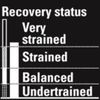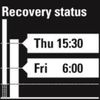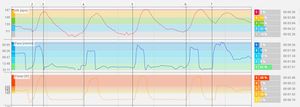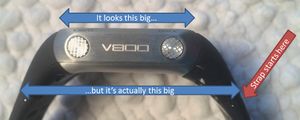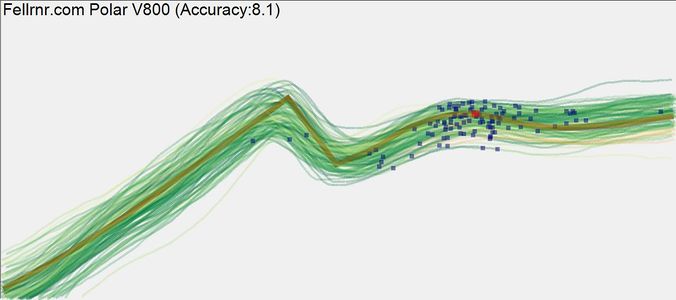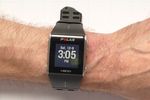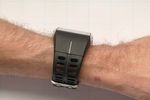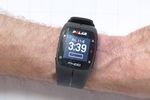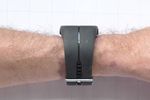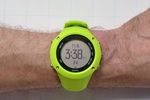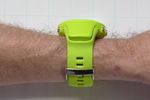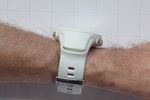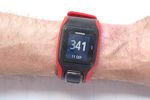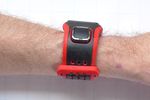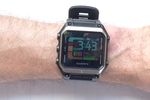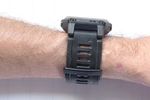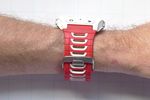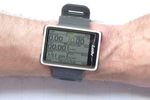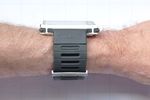Difference between revisions of "Polar V800"
User:Fellrnr (User talk:Fellrnr | contribs) |
User:Fellrnr (User talk:Fellrnr | contribs) |
||
| (13 intermediate revisions by the same user not shown) | |||
| Line 1: | Line 1: | ||
{{DISPLAYTITLE:Polar V800 Review}} | {{DISPLAYTITLE:Polar V800 Review}} | ||
| − | The {{Polar V800}} is elegant and has outstanding [[GPS Accuracy]], | + | The {{Polar V800}} is elegant and has outstanding [[GPS Accuracy]], and with time its price has dropped and its functionality has steadily improved as Polar released newer versions of the firmware, the app, and their web site. For a simple evaluation of a GPS watch, I look at how well it can answer some basic questions: |
| − | [[File:Polar V800.jpg| | + | * '''How far did I run?''' This is the most basic question, and the V800 has outstanding GPS accuracy. If you really want to know how far you've run, this is the best option other than getting a [[Stryd]] footpod, which the V800 supports well. |
| + | * '''How fast am I running?''' Knowing how fast you're running can be a nice to know, or it can be vital for your training or race performance. Because of the nature of GPS, watches that rely on GPS signal alone tend to have serious problems with current pace. Even with the outstanding GPS accuracy, the current pace can be a long way out. This is mostly due to the nature of GPS accuracy errors compared with Footpod errors. The V800 has great support for the [[Stryd]] footpod, making it a great choice. | ||
| + | * '''Where am I? '''The V800 has limited navigation features. | ||
| + | ** '''Course Outline'''. This is an outline of a route that can be downloaded. I've found this useful during ultras or in unfamiliar cities where I've needed to know where to go. However, there's no "Track Outline" showing where you've run (breadcrumb trail). | ||
| + | ** '''Back To Start'''. This is a simple arrow point to your starting point, so it won't help you backtrack. | ||
| + | ** '''Back To Waypoint'''. You can mark a location and use the arrow to point to it later. Again, this is a simple "as the crow flies" pointer. | ||
| + | ** '''GPS "Compass"'''. There's no magnetic compass so you have to be moving for the GPS to give you a sense of direction. | ||
| + | * '''What's my cadence? '''[[Cadence]]''' '''is one of the most critical and often overlooked aspects of running. If you get your Cadence right, many other things naturally fall into place. As of Feb 2016 the V800 supports Cadence measurement from the internal accelerometer and from Stryd, but no Cadence alerts. | ||
| + | [[File:Polar V800.jpg|center|thumb|200px|The {{Polar V800}}.]] | ||
| + | The V800 is rated at 13 hours, but I managed to get nearly 24 hours in testing. To get that life, I didn't press buttons or have Bluetooth connected, but that's still an impressive figure. It also has a rated 50 hour battery life if you activate extended mode which reduces the GPS accuracy. In addition the V800 can be charge on the run. See [[Best Running Watch#Watches for Ultrarunning| Watches for Ultrarunning]] for more details. | ||
| + | {{BuyAmazon|AZID=B00JSO9UD2|AZN=Polar V800}} | ||
| + | |||
=Polar V800 Pros= | =Polar V800 Pros= | ||
* The Polar V800 has considerably better [[GPS Accuracy]] than any other GPS watch I've tested. It's better than some of the older devices that have surprisingly good GPS Accuracy, and it's far better than most of the newer devices that have mediocre to appalling accuracy. (Note that even the V800 does not have sufficient GPS accuracy to give a good display of current pace.) | * The Polar V800 has considerably better [[GPS Accuracy]] than any other GPS watch I've tested. It's better than some of the older devices that have surprisingly good GPS Accuracy, and it's far better than most of the newer devices that have mediocre to appalling accuracy. (Note that even the V800 does not have sufficient GPS accuracy to give a good display of current pace.) | ||
| Line 9: | Line 20: | ||
** If you tap the V800 screen, that acts like an extra button. You can set the tap to take a lap, turn on the backlight or a few other things. (This tap does not seem to be a touchscreen and I found you have to whack the V800 pretty hard, even on the lightest setting. I think Polar is using the internal accelerometer to detect the impact.) | ** If you tap the V800 screen, that acts like an extra button. You can set the tap to take a lap, turn on the backlight or a few other things. (This tap does not seem to be a touchscreen and I found you have to whack the V800 pretty hard, even on the lightest setting. I think Polar is using the internal accelerometer to detect the impact.) | ||
** If you're wearing the heart rate monitor strap, you can touch the V800 to the transmitter for another action, such as activating the backlight. | ** If you're wearing the heart rate monitor strap, you can touch the V800 to the transmitter for another action, such as activating the backlight. | ||
| + | * Polar updated the V800 firmware to have great support of the [[Stryd]] footpod. It supports Stryd as a native power meter, which allows you to see not only the current power, but also average power, lap average power, and maximum power. You get the outstanding distance/pace accuracy of Stryd, along with the power estimate. | ||
| + | * The V800 supports [[Cadence]] from it's an internal accelerometer, something that was added in Feb 2016. You can also get a more accurate reading of Cadence via [[Stryd]], but other [[Footpod]] options are currently quite limited (see below). See [[Cadence]] for details of the internal accelerometer accuracy. | ||
* The V800 provides more information when you press the lap button than other watches, as well as far more useful data at the end of the run. | * The V800 provides more information when you press the lap button than other watches, as well as far more useful data at the end of the run. | ||
| − | * Like the [[Suunto Ambit2 | + | * Like the [[Suunto Ambit2]] and [[Suunto Ambit3]], the V800 can be configured via the website, which is easier than fiddling with the watch itself. Most of the options can be also set on the watch, which means you're not stuck if you're away from the Internet. |
| − | * With GPS recording set normally the battery life is 13 hours which is adequate for most runners. However ultrarunners may need to use the power save mode that extend the battery life up to 50 hours. While the documentation claims that the power save mode records GPS location once per minute, I've found that in practice it's a little more random than that (see below for details). | + | * With GPS recording set normally the battery life is 13 hours which is adequate for most runners, and I managed to get nearly 24 hours in my testing. However, ultrarunners may need to use the power save mode that extend the battery life up to 50 hours (I got just over 50 in my tests). While the documentation claims that the power save mode records GPS location once per minute, I've found that in practice it's a little more random than that (see below for details). The V800 can be charged on the run by plugging it into a portable USB battery. I have had instances where the V800 would reset on disconnect, but I suspect this might be an issue with the battery overall. |
* The V800 provides some interesting analysis of your training. This is similar to the [[Firstbeat| Firstbeat Training Effect]] used by Garmin and Suunto, which is a simple number between 1.0 and 5.0. The V800 provides more detailed analysis with a text description of its evaluation. It has 17 different classifications including things like "maximum training", "tempo training", or "steady-state training". Each classification has a little congratulatory message associated with it that explains the benefit of that particular type of training. This is a nice feature, though it can be a little simplistic and it was far less accurate for me than the [[Firstbeat]] approach. If you're prepared to take it with a pinch of salt, it's a nice feature. | * The V800 provides some interesting analysis of your training. This is similar to the [[Firstbeat| Firstbeat Training Effect]] used by Garmin and Suunto, which is a simple number between 1.0 and 5.0. The V800 provides more detailed analysis with a text description of its evaluation. It has 17 different classifications including things like "maximum training", "tempo training", or "steady-state training". Each classification has a little congratulatory message associated with it that explains the benefit of that particular type of training. This is a nice feature, though it can be a little simplistic and it was far less accurate for me than the [[Firstbeat]] approach. If you're prepared to take it with a pinch of salt, it's a nice feature. | ||
* The V800 also provides some guidance on your recovery. Again this is a little more sophisticated than the Garmin and Suunto approach which give the number of hours until you are recovered. | * The V800 also provides some guidance on your recovery. Again this is a little more sophisticated than the Garmin and Suunto approach which give the number of hours until you are recovered. | ||
| Line 27: | Line 40: | ||
* The V800 will only upload the data to the Polar website, but Polar has introduced the ability to export workouts in TCX format data. This is not as good as some other devices, but it's workable. | * The V800 will only upload the data to the Polar website, but Polar has introduced the ability to export workouts in TCX format data. This is not as good as some other devices, but it's workable. | ||
* You can use the V800 as a simple activity monitor, something that's common to many new sports watches. However, when the V800 acts as an activity monitor it only has only an internal accelerometer, which provides poor accuracy. If you need an activity monitor, I'd recommend the [[Basis Activity Tracker]] which has sensors for heart rate, skin temperature and perspiration. | * You can use the V800 as a simple activity monitor, something that's common to many new sports watches. However, when the V800 acts as an activity monitor it only has only an internal accelerometer, which provides poor accuracy. If you need an activity monitor, I'd recommend the [[Basis Activity Tracker]] which has sensors for heart rate, skin temperature and perspiration. | ||
| + | * While the polar website at the release of V800 was more of an unfinished beta release rather than a complete solution, it has improved with time. It's still not up to the standard of the Garmin web site, but I quite like it. Below is the analysis of a workout using [[Stryd]] power. <br/> [[File:Polar V800 Stryd.jpg|center|thumb|300px|]] | ||
* The V800 includes a thermometer, which I rather like, though obviously the accuracy suffers because it's attached to your arm. | * The V800 includes a thermometer, which I rather like, though obviously the accuracy suffers because it's attached to your arm. | ||
* You can use a Smartphone to upload your workouts to the Polar web site via Bluetooth. | * You can use a Smartphone to upload your workouts to the Polar web site via Bluetooth. | ||
=Polar V800 Cons= | =Polar V800 Cons= | ||
| − | * One of the big downsides to the V800 is its cost, | + | * One of the big downsides to the V800 is its cost, though it's been out long enough for the price to have dropped dramatically. |
| − | |||
* The V800 uses Bluetooth sensors rather than the more common Ant+, which has some practical implications. | * The V800 uses Bluetooth sensors rather than the more common Ant+, which has some practical implications. | ||
** For [[Heart Rate Monitor]], the Polar H7 works well. | ** For [[Heart Rate Monitor]], the Polar H7 works well. | ||
| − | ** The options for a [[Footpod]] are more limited (see below) | + | ** The options for a [[Footpod]] are more limited (see below). |
** An Ant+ sensor will broadcast data to any device that's listening, so you could have two watches both receiving information. Bluetooth sensors are currently limited to sending data to a single paired listening device. So if you're wearing the Polar H7 Heart Rate Monitor, the data can go either to the V800 or to your iPhone, not both. (The V800 will rebroadcast the signals, but currently only the Polar App can receive them. Later revisions of the Bluetooth specification will allow for broadcasting of data.) | ** An Ant+ sensor will broadcast data to any device that's listening, so you could have two watches both receiving information. Bluetooth sensors are currently limited to sending data to a single paired listening device. So if you're wearing the Polar H7 Heart Rate Monitor, the data can go either to the V800 or to your iPhone, not both. (The V800 will rebroadcast the signals, but currently only the Polar App can receive them. Later revisions of the Bluetooth specification will allow for broadcasting of data.) | ||
| − | * The support for [[ | + | * The support for a [[Footpod]] (other than [[Stryd]]) is more limited than I'd like. See [[Footpod]] for details. |
| − | |||
| − | |||
| − | |||
| − | |||
* The V800 uses some visual tricks to appear smaller than it is. If you look at the picture below, the watch body appears to be the silvered area, which is quite small. However, the first bit of the watch strap is really part of the watch body, with the strap starting much further out. The only problem is the watch body is inflexible, so on small wrists like mine it does not sit well, and I suspect it will dig into those with particularly large wrists. (I have no problem with watches that appear to be bigger, like the [[Garmin 310XT]], but I have to wear the V800 over a sweat band.)<br/>[[File:V800 Size.jpg|none|thumb|300px]] | * The V800 uses some visual tricks to appear smaller than it is. If you look at the picture below, the watch body appears to be the silvered area, which is quite small. However, the first bit of the watch strap is really part of the watch body, with the strap starting much further out. The only problem is the watch body is inflexible, so on small wrists like mine it does not sit well, and I suspect it will dig into those with particularly large wrists. (I have no problem with watches that appear to be bigger, like the [[Garmin 310XT]], but I have to wear the V800 over a sweat band.)<br/>[[File:V800 Size.jpg|none|thumb|300px]] | ||
* A minor irritation with the otherwise excellent user interface is that the beeps and vibration are extremely weak and ineffectual. | * A minor irritation with the otherwise excellent user interface is that the beeps and vibration are extremely weak and ineffectual. | ||
| − | |||
* The V800 will predict your [[VO2max|V̇O<sub>2</sub>max]], but unlike the Garmin devices that used [[Firstbeat]] technology and give a good result, the V800 is wildly wrong for me. Obviously this is a sample of one and Your Mileage May Vary. | * The V800 will predict your [[VO2max|V̇O<sub>2</sub>max]], but unlike the Garmin devices that used [[Firstbeat]] technology and give a good result, the V800 is wildly wrong for me. Obviously this is a sample of one and Your Mileage May Vary. | ||
* Another irritation is that the V800 will sometimes ask you a question when you press the start button, which is not the ideal time. | * Another irritation is that the V800 will sometimes ask you a question when you press the start button, which is not the ideal time. | ||
| + | * I have had some issues with the battery on my V800. When I allowed to fully discharge by not using it for weeks I had problems getting it to take or hold a charge. The V800 would claim it was fully charged, but then give a low battery warning almost immediately after disconnecting from the power. Leaving it on charge for a few days seemed to resolve the issue. | ||
=What's Missing= | =What's Missing= | ||
While I don't consider these missing features as 'cons', it's worth understanding the features that are missing compared with other watches. | While I don't consider these missing features as 'cons', it's worth understanding the features that are missing compared with other watches. | ||
| − | * '''Navigation.''' | + | * '''Navigation.''' Navigation capabilities are useful if there is a risk of getting lost, and the better watches will provide a display showing where you have run. I've made good use of this feature when running in an unfamiliar city, or when running remote trails. The V800 has a rudimentary "back to start" functionality that gives you an arrow pointing back, but that's a poor substitute. |
* '''Downloadable Apps'''. Smart watches have got is used to the idea of a device that can be extended with new functionality, and this concept is being introduced to running watches. | * '''Downloadable Apps'''. Smart watches have got is used to the idea of a device that can be extended with new functionality, and this concept is being introduced to running watches. | ||
* '''Graphs'''. Instead of simply displaying a numeric value for things like heart rate, some watches will display a graph of the value over time, giving you a sense of how things are progressing. | * '''Graphs'''. Instead of simply displaying a numeric value for things like heart rate, some watches will display a graph of the value over time, giving you a sense of how things are progressing. | ||
| Line 65: | Line 74: | ||
|[[File:Polar V800 Power Save.jpg|none|thumb|x300px|The GPS track from the Polar V800 in power save mode. Each blue dot is a GPS point from an out and back run that, with the route covered twice at a steady pace. You can see areas where the V800 is recording the GPS location quite frequently, and other times the frequency is quite low.]] | |[[File:Polar V800 Power Save.jpg|none|thumb|x300px|The GPS track from the Polar V800 in power save mode. Each blue dot is a GPS point from an out and back run that, with the route covered twice at a steady pace. You can see areas where the V800 is recording the GPS location quite frequently, and other times the frequency is quite low.]] | ||
|} | |} | ||
| − | { | + | =Visual Comparison= |
| + | {| class="wikitable" | ||
| + | |- valign="top" | ||
| + | |[[File:Polar V800-top.JPG|none|thumb|150px|Polar V800 top]] | ||
| + | |[[File:Polar V800-side.JPG|none|thumb|150px|Polar V800 side]] | ||
| + | |[[File:Polar M400-top.JPG|none|thumb|150px|Polar M400 top]] | ||
| + | |[[File:Polar M400-side.JPG|none|thumb|150px|Polar M400 side]] | ||
| + | |- valign="top" | ||
| + | |[[File:Suunto Ambit3-top.JPG|none|thumb|150px|Suunto Ambit3 top]] | ||
| + | |[[File:Suunto Ambit3-side.JPG|none|thumb|150px|Suunto Ambit3 side]] | ||
| + | |[[File:Suunto Ambit2-top.JPG|none|thumb|150px|Suunto Ambit2 top]] | ||
| + | |[[File:Suunto Ambit2-side.JPG|none|thumb|150px|Suunto Ambit2 side]] | ||
| + | |- valign="top" | ||
| + | |[[File:TomTom Cardio Runner-top.JPG|none|thumb|150px|TomTom Cardio Runner top]] | ||
| + | |[[File:TomTom Cardio Runner-side.JPG|none|thumb|150px|TomTom Cardio Runner side]] | ||
| + | |[[File:Garmin Epix-top.JPG|none|thumb|150px|Garmin Epix top]] | ||
| + | |[[File:Garmin Epix-side.JPG|none|thumb|150px|Garmin Epix side]] | ||
| + | |- valign="top" | ||
| + | |[[File:Garmin 920XT-top.JPG|none|thumb|150px|Garmin 920XT top]] | ||
| + | |[[File:Garmin 920XT-side.JPG|none|thumb|150px|Garmin 920XT side]] | ||
| + | |[[File:Garmin 620-top.JPG|none|thumb|150px|Garmin 620 top]] | ||
| + | |[[File:Garmin 620-side.JPG|none|thumb|150px|Garmin 620 side]] | ||
| + | |- valign="top" | ||
| + | |[[File:Leikr 1-top.JPG|none|thumb|150px|Leikr 1 top]] | ||
| + | |[[File:Leikr 1-side.JPG|none|thumb|150px|Leikr 1 side]] | ||
| + | |} | ||
=Comparison Table= | =Comparison Table= | ||
{{:Best Running Watch-table}} | {{:Best Running Watch-table}} | ||
Latest revision as of 16:58, 27 November 2019
The Polar V800 is elegant and has outstanding GPS Accuracy, and with time its price has dropped and its functionality has steadily improved as Polar released newer versions of the firmware, the app, and their web site. For a simple evaluation of a GPS watch, I look at how well it can answer some basic questions:
- How far did I run? This is the most basic question, and the V800 has outstanding GPS accuracy. If you really want to know how far you've run, this is the best option other than getting a Stryd footpod, which the V800 supports well.
- How fast am I running? Knowing how fast you're running can be a nice to know, or it can be vital for your training or race performance. Because of the nature of GPS, watches that rely on GPS signal alone tend to have serious problems with current pace. Even with the outstanding GPS accuracy, the current pace can be a long way out. This is mostly due to the nature of GPS accuracy errors compared with Footpod errors. The V800 has great support for the Stryd footpod, making it a great choice.
- Where am I? The V800 has limited navigation features.
- Course Outline. This is an outline of a route that can be downloaded. I've found this useful during ultras or in unfamiliar cities where I've needed to know where to go. However, there's no "Track Outline" showing where you've run (breadcrumb trail).
- Back To Start. This is a simple arrow point to your starting point, so it won't help you backtrack.
- Back To Waypoint. You can mark a location and use the arrow to point to it later. Again, this is a simple "as the crow flies" pointer.
- GPS "Compass". There's no magnetic compass so you have to be moving for the GPS to give you a sense of direction.
- What's my cadence? Cadence is one of the most critical and often overlooked aspects of running. If you get your Cadence right, many other things naturally fall into place. As of Feb 2016 the V800 supports Cadence measurement from the internal accelerometer and from Stryd, but no Cadence alerts.
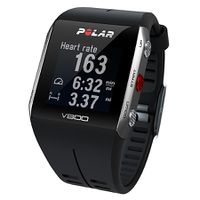
The V800 is rated at 13 hours, but I managed to get nearly 24 hours in testing. To get that life, I didn't press buttons or have Bluetooth connected, but that's still an impressive figure. It also has a rated 50 hour battery life if you activate extended mode which reduces the GPS accuracy. In addition the V800 can be charge on the run. See Watches for Ultrarunning for more details.

| This review was made possible by readers like you buying products via my links. I buy all the products I review through normal retail channels, which allows me to create unbiased reviews free from the influence of reciprocity, or the need to keep vendors happy. It also ensures I don't get "reviewer specials" that are better than the retail versions.
|
Contents
[hide]1 Polar V800 Pros
- The Polar V800 has considerably better GPS Accuracy than any other GPS watch I've tested. It's better than some of the older devices that have surprisingly good GPS Accuracy, and it's far better than most of the newer devices that have mediocre to appalling accuracy. (Note that even the V800 does not have sufficient GPS accuracy to give a good display of current pace.)
- The V800 also has a more rapid initial satellite acquisition than earlier watches, though it's not as fast as the watches that use a satellite pre-cache download.
- The Polar V800 has elegant styling and it's made from beautiful materials. It's so aesthetically pleasing that it makes me think it's an Apple product. The V800 is actually quite heavy, but this tends to convey a sense of quality rather than excess.
- The elegant design continues into the user interface; the buttons, display, and the menu system combine aesthetics with usability. The V800 has five hard buttons, which I much prefer over a touchscreen interface, especially when wearing gloves or in the rain.
- If you tap the V800 screen, that acts like an extra button. You can set the tap to take a lap, turn on the backlight or a few other things. (This tap does not seem to be a touchscreen and I found you have to whack the V800 pretty hard, even on the lightest setting. I think Polar is using the internal accelerometer to detect the impact.)
- If you're wearing the heart rate monitor strap, you can touch the V800 to the transmitter for another action, such as activating the backlight.
- Polar updated the V800 firmware to have great support of the Stryd footpod. It supports Stryd as a native power meter, which allows you to see not only the current power, but also average power, lap average power, and maximum power. You get the outstanding distance/pace accuracy of Stryd, along with the power estimate.
- The V800 supports Cadence from it's an internal accelerometer, something that was added in Feb 2016. You can also get a more accurate reading of Cadence via Stryd, but other Footpod options are currently quite limited (see below). See Cadence for details of the internal accelerometer accuracy.
- The V800 provides more information when you press the lap button than other watches, as well as far more useful data at the end of the run.
- Like the Suunto Ambit2 and Suunto Ambit3, the V800 can be configured via the website, which is easier than fiddling with the watch itself. Most of the options can be also set on the watch, which means you're not stuck if you're away from the Internet.
- With GPS recording set normally the battery life is 13 hours which is adequate for most runners, and I managed to get nearly 24 hours in my testing. However, ultrarunners may need to use the power save mode that extend the battery life up to 50 hours (I got just over 50 in my tests). While the documentation claims that the power save mode records GPS location once per minute, I've found that in practice it's a little more random than that (see below for details). The V800 can be charged on the run by plugging it into a portable USB battery. I have had instances where the V800 would reset on disconnect, but I suspect this might be an issue with the battery overall.
- The V800 provides some interesting analysis of your training. This is similar to the Firstbeat Training Effect used by Garmin and Suunto, which is a simple number between 1.0 and 5.0. The V800 provides more detailed analysis with a text description of its evaluation. It has 17 different classifications including things like "maximum training", "tempo training", or "steady-state training". Each classification has a little congratulatory message associated with it that explains the benefit of that particular type of training. This is a nice feature, though it can be a little simplistic and it was far less accurate for me than the Firstbeat approach. If you're prepared to take it with a pinch of salt, it's a nice feature.
- The V800 also provides some guidance on your recovery. Again this is a little more sophisticated than the Garmin and Suunto approach which give the number of hours until you are recovered.
- The V800 will tell you how many hours of recovery are required for the latest workout, which gives a nice evaluation of that workout in isolation.
- The V800 will give you your overall recovery/stress level as a bar graph.
- The V800 will then tell you when you will reach the next recovery level.
- I think this is rather more useful information than the Firstbeat systems used by Garmin and Suunto, but I'm not convinced it's as accurate.
- The V800 can include stress/recovery information from general daily activity as well as exercise sessions, which is nice. However, because the V800 is a poor activity monitor (see below), this value is a little limited.
- The V800 can display your Heart Rate Variability (HRV), something that is quite unusual. I really like having HRV displayed, as it gives another indication of how stressful my current training session is. The V800 can also record your HRV, but not during a normal training session.
- There are a number of tests built into the V800.
- The fitness test uses the Heart Rate Monitor to measure your Heart Rate Variability at rest to predict your V̇O2max (a measure of fitness).
- The orthostatic test measures your Heart Rate and HRV lying down and when you stand up to evaluate your recovery status. This test takes six minutes and needs to be done on a regular basis in order to detect patterns of change. Looking at the scientific research, the reliability of this test is unclear.
- There are jumping tests that use the Polar Stride Sensor to measure explosive strength.
- The V800 includes a barometric altimeter, which is helpful given that GPS is notoriously poor at estimating altitude.
- The V800 will only upload the data to the Polar website, but Polar has introduced the ability to export workouts in TCX format data. This is not as good as some other devices, but it's workable.
- You can use the V800 as a simple activity monitor, something that's common to many new sports watches. However, when the V800 acts as an activity monitor it only has only an internal accelerometer, which provides poor accuracy. If you need an activity monitor, I'd recommend the Basis Activity Tracker which has sensors for heart rate, skin temperature and perspiration.
- While the polar website at the release of V800 was more of an unfinished beta release rather than a complete solution, it has improved with time. It's still not up to the standard of the Garmin web site, but I quite like it. Below is the analysis of a workout using Stryd power.
- The V800 includes a thermometer, which I rather like, though obviously the accuracy suffers because it's attached to your arm.
- You can use a Smartphone to upload your workouts to the Polar web site via Bluetooth.
2 Polar V800 Cons
- One of the big downsides to the V800 is its cost, though it's been out long enough for the price to have dropped dramatically.
- The V800 uses Bluetooth sensors rather than the more common Ant+, which has some practical implications.
- For Heart Rate Monitor, the Polar H7 works well.
- The options for a Footpod are more limited (see below).
- An Ant+ sensor will broadcast data to any device that's listening, so you could have two watches both receiving information. Bluetooth sensors are currently limited to sending data to a single paired listening device. So if you're wearing the Polar H7 Heart Rate Monitor, the data can go either to the V800 or to your iPhone, not both. (The V800 will rebroadcast the signals, but currently only the Polar App can receive them. Later revisions of the Bluetooth specification will allow for broadcasting of data.)
- The support for a Footpod (other than Stryd) is more limited than I'd like. See Footpod for details.
- The V800 uses some visual tricks to appear smaller than it is. If you look at the picture below, the watch body appears to be the silvered area, which is quite small. However, the first bit of the watch strap is really part of the watch body, with the strap starting much further out. The only problem is the watch body is inflexible, so on small wrists like mine it does not sit well, and I suspect it will dig into those with particularly large wrists. (I have no problem with watches that appear to be bigger, like the Garmin 310XT, but I have to wear the V800 over a sweat band.)
- A minor irritation with the otherwise excellent user interface is that the beeps and vibration are extremely weak and ineffectual.
- The V800 will predict your V̇O2max, but unlike the Garmin devices that used Firstbeat technology and give a good result, the V800 is wildly wrong for me. Obviously this is a sample of one and Your Mileage May Vary.
- Another irritation is that the V800 will sometimes ask you a question when you press the start button, which is not the ideal time.
- I have had some issues with the battery on my V800. When I allowed to fully discharge by not using it for weeks I had problems getting it to take or hold a charge. The V800 would claim it was fully charged, but then give a low battery warning almost immediately after disconnecting from the power. Leaving it on charge for a few days seemed to resolve the issue.
3 What's Missing
While I don't consider these missing features as 'cons', it's worth understanding the features that are missing compared with other watches.
- Navigation. Navigation capabilities are useful if there is a risk of getting lost, and the better watches will provide a display showing where you have run. I've made good use of this feature when running in an unfamiliar city, or when running remote trails. The V800 has a rudimentary "back to start" functionality that gives you an arrow pointing back, but that's a poor substitute.
- Downloadable Apps. Smart watches have got is used to the idea of a device that can be extended with new functionality, and this concept is being introduced to running watches.
- Graphs. Instead of simply displaying a numeric value for things like heart rate, some watches will display a graph of the value over time, giving you a sense of how things are progressing.
- Running Dynamics. Some of the newer Garmin watches can show and record Vertical Oscillation (VO) and Ground Contact Time (GCT).
- Alerts. Some watches will alert you when a metric is out of range. The alert for Cadence is really useful and one of my favorite features.
4 GPS Accuracy
The V800 has great GPS accuracy, the best of any device I've test so far. The V800 uses the SiRF chipset, which seems to have the capacity for great accuracy.
5 Visual Comparison
6 Comparison Table
I evaluate running watches in three distinct ways. Firstly, you can use a watch on its own, without any kind of Footpod. This is probably the most common way runners use their watch, but you miss out on a lot. The second rating is with a standard Footpod that is available quite cheaply. These Footpod's can be reasonably accurate once the calibrated, but calibration is a little tedious. The final evaluation is with the Stryd Footpod, which is vastly more accurate than any other type of Footpod, or and more accurate than GPS. The table below looks at the score, and the value for money of each watch for each of the three conditions. (I’ve also tested the Apple Watch 3, but I’ve not included it in these tables as it’s not really a running watch.)
| Review ▼ | With Stryd Score | With Stryd Value for money | With Footpod Score | With Footpod Value for money | Without Footpod Score | Without Footpod Value for money | Price at Amazon.com |
|---|---|---|---|---|---|---|---|
| Garmin Epix Review | 47 | 4.5 | 31 | 3.9 | 23 | 3.4 | Error: Could not parse data from Amazon! |
| Garmin Fenix 5X Review | 47 | 2.9 | 32 | 2.3 | 24 | 1.9 | Error: Could not parse data from Amazon! |
| Garmin Fenix 3 Review | 45 | 3.8 | 28 | 3.1 | 24 | 3 | Error: Could not parse data from Amazon! |
| Garmin 935 Review | 45 | 3.6 | 30 | 3 | 22 | 2.4 | Error: Could not parse data from Amazon! |
| Garmin Vivoactive HR Review | 40 | 4.9 | 21 | 3.8 | 17 | 3.8 | Error: Could not parse data from Amazon! |
| Garmin 920XT Review | 39 | 4.4 | 30 | 4.7 | 24 | 4.5 | Error: Could not parse data from Amazon! |
| Suunto Spartan Ultra Review | 37 | 2.6 | 27 | 2.3 | 23 | 2.1 | Error: Could not parse data from Amazon! |
| Garmin Vivoactive 3 Review | 36 | 4 | 19 | 2.9 | 15 | 2.8 | Error: Could not parse data from Amazon! |
| Garmin Vivoactive Review | 34 | 5.1 | 14 | 3.4 | 10 | 3.3 | Error: Could not parse data from Amazon! |
| Suunto Spartan Trainer Review | 34 | 3.9 | 23 | 3.7 | 18 | 3.4 | Error: Could not parse data from Amazon! |
| Polar V800 Review | 33 | 2.8 | 26 | 2.8 | 22 | 2.7 | Error: Could not parse data from Amazon! |
| Suunto Ambit2 Review | 32 | 3.9 | 25 | 4.3 | 21 | 4.5 | Error: Could not parse data from Amazon! |
| Suunto Ambit3 Peak Review | 32 | 3.4 | 29 | 4.1 | 25 | 4.2 | Error: Could not parse data from Amazon! |
| Garmin Fenix 2 Review | 31 | 2.9 | 22 | 2.7 | 18 | 2.5 | Error: Could not parse data from Amazon! |
| Suunto Ambit3 Run Review | 30 | 4 | 27 | 5.5 | 23 | 5.9 | Error: Could not parse data from Amazon! |
| Suunto Ambit2 R Review | 30 | 3.5 | 23 | 3.8 | 19 | 3.8 | Error: Could not parse data from Amazon! |
| Garmin 235 Review | 28 | 2.9 | 20 | 2.8 | 12 | 2 | Error: Could not parse data from Amazon! |
| Garmin 620 Review | 27 | 3.8 | 24 | 5.1 | 20 | 5.6 | Error: Could not parse data from Amazon! |
| Garmin 910XT Review | 26 | 3.9 | 26 | 6.1 | 21 | 6.7 | Error: Could not parse data from Amazon! |
| Garmin 310XT Review | 25 | 4.6 | 24 | 8.3 | 18 | 10 | Error: Could not parse data from Amazon! |
| Polar M400 Review | 25 | 4.3 | 15 | 4.5 | 11 | 4.9 | Error: Could not parse data from Amazon! |
| Garmin 225 Review | 25 | 3.8 | 13 | 3.1 | 9 | 2.9 | Error: Could not parse data from Amazon! |
| TomTom Cardio Runner Review | 25 | 3.3 | 10 | 2 | 10 | 2.5 | Error: Could not parse data from Amazon! |
| Polar M430 Review | 25 | 3.2 | 15 | 2.9 | 11 | 2.7 | Error: Could not parse data from Amazon! |
| Garmin 610 Review | 24 | 3.3 | 20 | 4.3 | 14 | 3.9 | Error: Could not parse data from Amazon! |
| Leikr Review | 10 | 1 | 20 | 2.5 | 14 | 2 | Leikr ($380) |
| Epson SF-510 Review | 4 | 0.7 | 6 | 2 | 6 | 3 | Error: Could not parse data from Amazon! |
| Epson SF-810 Review | 4 | 0.6 | 6 | 1.6 | 6 | 2.3 | Error: Could not parse data from Amazon! |
| Garmin 10 Review | 2 | 0.3 | 2 | 0.6 | 2 | 0.9 | Error: Could not parse data from Amazon! |
The score is the sum of how well each watch can answer the four basic questions (how far, how fast, where are you, what's your cadence), plus some bonus points.
- The "How far you've run" will be based on GPS only for "without Footpod" and "with Standard Footpod", but based on Stryd if supported in the "with Stryd Footpod" table..
- How fast you're running assumes you're using a Footpod if it's supported, otherwise the rating is 0-2 based on GPS accuracy.
- The "Where are you?" is based on various navigation features such as back to start, breadcrumbs, and preloaded maps. For some watches, you have to turn GPS off to get the benefit of Stryd, so those watches have worse "where are you scores" with Stryd than without.
- The cadence score uses 1 point for an internal cadence sensor, 2 points for footpod support, 1 point for support from chest strap cadence, and 1 point for cadence alerts.
- I give 1-2 bonus points for application support, 1-2 bonus points for data upload, 1-2 bonus points for Optical Heart Rate Monitoring, and 0-1 bonus points for battery life.
- Value for money is the score divided by the price (at the time I last updated the table.) Your needs may be different, so you might weight the different aspects of the watches differently, or be basing your decision on different criteria totally. Hopefully this table will give you a good starting point for your decision.
6.1 Score Breakdown without a Footpod
| Review ▼ | Score | Value for money6 | How far did you run?1 |
How fast are you running?2 |
Where are you?3 |
What's your cadence?4 |
Bonus Points5 | class="unsortable" |
Price at Amazon.com |
|---|---|---|---|---|---|---|---|---|
| Suunto Ambit3 Peak Review | 25 | 4.2 | 8 | 3 | 6 | 2 | 6 | Error: Could not parse data from Amazon! |
| Garmin 920XT Review | 24 | 4.5 | 1 | 2 | 7 | 6 | 8 | Error: Could not parse data from Amazon! |
| Garmin Fenix 3 Review | 24 | 3 | 2 | 1 | 7 | 6 | 8 | Error: Could not parse data from Amazon! |
| Garmin Fenix 5X Review | 24 | 1.9 | 1 | 0 | 9 | 6 | 8 | Error: Could not parse data from Amazon! |
| Suunto Ambit3 Run Review | 23 | 5.9 | 8 | 3 | 5 | 2 | 5 | Error: Could not parse data from Amazon! |
| Garmin Epix Review | 23 | 3.4 | 0 | 0 | 9 | 6 | 8 | Error: Could not parse data from Amazon! |
| Suunto Spartan Ultra Review | 23 | 2.1 | 8 | 2 | 6 | 2 | 5 | Error: Could not parse data from Amazon! |
| Polar V800 Review | 22 | 2.7 | 9 | 4 | 3 | 2 | 4 | Error: Could not parse data from Amazon! |
| Garmin 935 Review | 22 | 2.4 | 1 | 0 | 7 | 6 | 8 | Error: Could not parse data from Amazon! |
| Garmin 910XT Review | 21 | 6.7 | 5 | 3 | 6 | 2 | 5 | Error: Could not parse data from Amazon! |
| Suunto Ambit2 Review | 21 | 4.5 | 4 | 3 | 6 | 2 | 6 | Error: Could not parse data from Amazon! |
| Garmin 620 Review | 20 | 5.6 | 3 | 2 | 2 | 6 | 7 | Error: Could not parse data from Amazon! |
| Suunto Ambit2 R Review | 19 | 3.8 | 4 | 3 | 5 | 2 | 5 | Error: Could not parse data from Amazon! |
| Garmin 310XT Review | 18 | 10 | 7 | 2 | 4 | 0 | 5 | Error: Could not parse data from Amazon! |
| Suunto Spartan Trainer Review | 18 | 3.4 | 5 | 3 | 4 | 2 | 4 | Error: Could not parse data from Amazon! |
| Garmin Fenix 2 Review | 18 | 2.5 | 1 | 0 | 6 | 6 | 5 | Error: Could not parse data from Amazon! |
| Garmin Vivoactive HR Review | 17 | 3.8 | 0 | 0 | 2 | 6 | 9 | Error: Could not parse data from Amazon! |
| Garmin Vivoactive 3 Review | 15 | 2.8 | 0 | 0 | 4 | 4 | 7 | Error: Could not parse data from Amazon! |
| Garmin 610 Review | 14 | 3.9 | 3 | 2 | 3 | 2 | 4 | Error: Could not parse data from Amazon! |
| Leikr Review | 14 | 2 | 5 | 2 | 4 | 0 | 3 | Leikr ($380) |
| Garmin 235 Review | 12 | 2 | 0 | 0 | 2 | 2 | 8 | Error: Could not parse data from Amazon! |
| Polar M400 Review | 11 | 4.9 | 3 | 1 | 1 | 2 | 4 | Error: Could not parse data from Amazon! |
| Polar M430 Review | 11 | 2.7 | 3 | 1 | 1 | 2 | 4 | Error: Could not parse data from Amazon! |
| Garmin Vivoactive Review | 10 | 3.3 | 0 | 0 | 0 | 6 | 4 | Error: Could not parse data from Amazon! |
| TomTom Cardio Runner Review | 10 | 2.5 | 2 | 1 | 0 | 2 | 5 | Error: Could not parse data from Amazon! |
| Garmin 225 Review | 9 | 2.9 | 1 | 1 | 0 | 2 | 5 | Error: Could not parse data from Amazon! |
| Epson SF-510 Review | 6 | 3 | 0 | 0 | 0 | 2 | 4 | Error: Could not parse data from Amazon! |
| Epson SF-810 Review | 6 | 2.3 | 1 | 0 | 0 | 2 | 3 | Error: Could not parse data from Amazon! |
| Garmin 10 Review | 2 | 0.9 | 0 | 0 | 0 | 0 | 2 | Error: Could not parse data from Amazon! |
6.2 Score Breakdown with a Standard Footpod
| Review ▼ | Score | Value for money6 | How far did you run?1 |
How fast are you running?2 |
Where are you?3 |
What's your cadence?4 |
Bonus Points5 | class="unsortable" |
Price at Amazon.com |
|---|---|---|---|---|---|---|---|---|
| Garmin Fenix 5X Review | 32 | 2.3 | 1 | 4 | 9 | 10 | 8 | Error: Could not parse data from Amazon! |
| Garmin Epix Review | 31 | 3.9 | 0 | 4 | 9 | 10 | 8 | Error: Could not parse data from Amazon! |
| Garmin 920XT Review | 30 | 4.7 | 1 | 4 | 7 | 10 | 8 | Error: Could not parse data from Amazon! |
| Garmin 935 Review | 30 | 3 | 1 | 4 | 7 | 10 | 8 | Error: Could not parse data from Amazon! |
| Suunto Ambit3 Peak Review | 29 | 4.1 | 8 | 3 | 6 | 6 | 6 | Error: Could not parse data from Amazon! |
| Garmin Fenix 3 Review | 28 | 3.1 | 2 | 1 | 7 | 10 | 8 | Error: Could not parse data from Amazon! |
| Suunto Ambit3 Run Review | 27 | 5.5 | 8 | 3 | 5 | 6 | 5 | Error: Could not parse data from Amazon! |
| Suunto Spartan Ultra Review | 27 | 2.3 | 8 | 2 | 6 | 6 | 5 | Error: Could not parse data from Amazon! |
| Garmin 910XT Review | 26 | 6.1 | 5 | 4 | 6 | 6 | 5 | Error: Could not parse data from Amazon! |
| Polar V800 Review | 26 | 2.8 | 9 | 4 | 3 | 6 | 4 | Error: Could not parse data from Amazon! |
| Suunto Ambit2 Review | 25 | 4.3 | 4 | 3 | 6 | 6 | 6 | Error: Could not parse data from Amazon! |
| Garmin 310XT Review | 24 | 8.3 | 7 | 4 | 4 | 4 | 5 | Error: Could not parse data from Amazon! |
| Garmin 620 Review | 24 | 5.1 | 3 | 2 | 2 | 10 | 7 | Error: Could not parse data from Amazon! |
| Suunto Ambit2 R Review | 23 | 3.8 | 4 | 3 | 5 | 6 | 5 | Error: Could not parse data from Amazon! |
| Suunto Spartan Trainer Review | 23 | 3.7 | 5 | 4 | 4 | 6 | 4 | Error: Could not parse data from Amazon! |
| Garmin Fenix 2 Review | 22 | 2.7 | 1 | 0 | 6 | 10 | 5 | Error: Could not parse data from Amazon! |
| Garmin Vivoactive HR Review | 21 | 3.8 | 0 | 0 | 2 | 10 | 9 | Error: Could not parse data from Amazon! |
| Garmin 610 Review | 20 | 4.3 | 3 | 4 | 3 | 6 | 4 | Error: Could not parse data from Amazon! |
| Garmin 235 Review | 20 | 2.8 | 0 | 4 | 2 | 6 | 8 | Error: Could not parse data from Amazon! |
| Leikr Review | 20 | 2.5 | 5 | 4 | 4 | 4 | 3 | Leikr ($380) |
| Garmin Vivoactive 3 Review | 19 | 2.9 | 0 | 0 | 4 | 8 | 7 | Error: Could not parse data from Amazon! |
| Polar M400 Review | 15 | 4.5 | 3 | 1 | 1 | 6 | 4 | Error: Could not parse data from Amazon! |
| Polar M430 Review | 15 | 2.9 | 3 | 1 | 1 | 6 | 4 | Error: Could not parse data from Amazon! |
| Garmin Vivoactive Review | 14 | 3.4 | 0 | 0 | 0 | 10 | 4 | Error: Could not parse data from Amazon! |
| Garmin 225 Review | 13 | 3.1 | 1 | 1 | 0 | 6 | 5 | Error: Could not parse data from Amazon! |
| TomTom Cardio Runner Review | 10 | 2 | 2 | 1 | 0 | 2 | 5 | Error: Could not parse data from Amazon! |
| Epson SF-510 Review | 6 | 2 | 0 | 0 | 0 | 2 | 4 | Error: Could not parse data from Amazon! |
| Epson SF-810 Review | 6 | 1.6 | 1 | 0 | 0 | 2 | 3 | Error: Could not parse data from Amazon! |
| Garmin 10 Review | 2 | 0.6 | 0 | 0 | 0 | 0 | 2 | Error: Could not parse data from Amazon! |
6.3 Score Breakdown with a Stryd Footpod
| Review ▼ | Score | Value for money6 | How far did you run?1 |
How fast are you running?2 |
Where are you?3 |
What's your cadence?4 |
Bonus Points5 | class="unsortable" |
Price at Amazon.com |
|---|---|---|---|---|---|---|---|---|
| Garmin Epix Review | 47 | 4.5 | 10 | 10 | 9 | 10 | 8 | Error: Could not parse data from Amazon! |
| Garmin Fenix 5X Review | 47 | 2.9 | 10 | 10 | 9 | 10 | 8 | Error: Could not parse data from Amazon! |
| Garmin Fenix 3 Review | 45 | 3.8 | 10 | 10 | 7 | 10 | 8 | Error: Could not parse data from Amazon! |
| Garmin 935 Review | 45 | 3.6 | 10 | 10 | 7 | 10 | 8 | Error: Could not parse data from Amazon! |
| Garmin Vivoactive HR Review | 40 | 4.9 | 10 | 10 | 1 | 10 | 9 | Error: Could not parse data from Amazon! |
| Garmin 920XT Review | 39 | 4.4 | 10 | 10 | 1 | 10 | 8 | Error: Could not parse data from Amazon! |
| Suunto Spartan Ultra Review | 37 | 2.6 | 10 | 10 | 6 | 6 | 5 | Error: Could not parse data from Amazon! |
| Garmin Vivoactive 3 Review | 36 | 4 | 10 | 10 | 1 | 8 | 7 | Error: Could not parse data from Amazon! |
| Garmin Vivoactive Review | 34 | 5.1 | 10 | 10 | 0 | 10 | 4 | Error: Could not parse data from Amazon! |
| Suunto Spartan Trainer Review | 34 | 3.9 | 10 | 10 | 4 | 6 | 4 | Error: Could not parse data from Amazon! |
| Polar V800 Review | 33 | 2.8 | 10 | 10 | 3 | 6 | 4 | Error: Could not parse data from Amazon! |
| Suunto Ambit2 Review | 32 | 3.9 | 10 | 10 | 6 | 0 | 6 | Error: Could not parse data from Amazon! |
| Suunto Ambit3 Peak Review | 32 | 3.4 | 10 | 10 | 6 | 0 | 6 | Error: Could not parse data from Amazon! |
| Garmin Fenix 2 Review | 31 | 2.9 | 10 | 10 | 6 | 0 | 5 | Error: Could not parse data from Amazon! |
| Suunto Ambit3 Run Review | 30 | 4 | 10 | 10 | 5 | 0 | 5 | Error: Could not parse data from Amazon! |
| Suunto Ambit2 R Review | 30 | 3.5 | 10 | 10 | 5 | 0 | 5 | Error: Could not parse data from Amazon! |
| Garmin 235 Review | 28 | 2.9 | 10 | 10 | 0 | 0 | 8 | Error: Could not parse data from Amazon! |
| Garmin 620 Review | 27 | 3.8 | 10 | 10 | 0 | 0 | 7 | Error: Could not parse data from Amazon! |
| Garmin 910XT Review | 26 | 3.9 | 10 | 10 | 1 | 0 | 5 | Error: Could not parse data from Amazon! |
| Garmin 310XT Review | 25 | 4.6 | 10 | 10 | 0 | 0 | 5 | Error: Could not parse data from Amazon! |
| Polar M400 Review | 25 | 4.3 | 10 | 10 | 1 | 0 | 4 | Error: Could not parse data from Amazon! |
| Garmin 225 Review | 25 | 3.8 | 10 | 10 | 0 | 0 | 5 | Error: Could not parse data from Amazon! |
| TomTom Cardio Runner Review | 25 | 3.3 | 10 | 10 | 0 | 0 | 5 | Error: Could not parse data from Amazon! |
| Polar M430 Review | 25 | 3.2 | 10 | 10 | 1 | 0 | 4 | Error: Could not parse data from Amazon! |
| Garmin 610 Review | 24 | 3.3 | 10 | 10 | 0 | 0 | 4 | Error: Could not parse data from Amazon! |
| Leikr Review | 10 | 1 | 5 | 2 | 0 | 0 | 3 | Leikr ($380) |
| Epson SF-510 Review | 4 | 0.7 | 0 | 0 | 0 | 0 | 4 | Error: Could not parse data from Amazon! |
| Epson SF-810 Review | 4 | 0.6 | 1 | 0 | 0 | 0 | 3 | Error: Could not parse data from Amazon! |
| Garmin 10 Review | 2 | 0.3 | 0 | 0 | 0 | 0 | 2 | Error: Could not parse data from Amazon! |
6.4 Basic Features
|
Review ▼ |
Released | GPS Accuracy |
Weight (oz) | Size (CM3) | Display (mm) | Resolution (Pixels) | Waterproofing ▼ | Heart Rate Monitor ▼ |
Cadence ▼ | Data Upload ▼ |
|---|---|---|---|---|---|---|---|---|---|---|
| Garmin Epix Review | 2015 | 6.2 | 3.0 | 48 | 29 x 21 (609mm2) | 205 x 148 (30.3K total) | Good (50m) | Yes | Internal/Footpod/Heart Rate Monitor/Alert | Yes |
| Garmin Fenix 5X Review | 2017 | 5.6 | 3.5 | 36 | 30.5 (round) (731mm2) | 240 diameter (45.2K total) | Good (100m) | Yes | Internal/Footpod/Heart Rate Monitor/Alert | Yes |
| Garmin Fenix 3 Review | 2015 | 6.2 | 2.9 | 33 | 30 (round) (726mm2) | 218 diameter (37.3K total) | Good (100m) | Yes | Internal/Footpod/Heart Rate Monitor/Alert | Yes |
| Garmin 935 Review | 2017 | 5.6 | 1.7 | 24 | 30.5 (round) (731mm2) | 240 diameter (45.2K total) | Good (100m) | Yes | Internal/Footpod/Heart Rate Monitor/Alert | Yes |
| Garmin Vivoactive HR Review | 2016 | 4.9 | 1.7 | 19 | 21 x 29 (609mm2) | 148 x 205 (30.3K total) | Good (50m) | Yes (+OHRM) | Internal/Footpod/Heart Rate Monitor/Alert | Yes |
| Garmin 920XT Review | 2014 | 6.6 | 2.2 | 35 | 29 x 21 (609mm2) | 205 x 148 (30.3K total) | Good (50m) | Yes | Internal/Footpod/Heart Rate Monitor/Alert | Yes |
| Garmin Vivoactive 3 Review | 2017 | 1.5 | 17 | 30.5 (round) (731mm2) | 240 diameter (45.2K total) | Good (50m) | Yes (+OHRM) | Internal/Footpod | Yes | |
| Garmin Vivoactive Review | 2015 | 5.4 | 1.3 | 13 | 29 x 21 (592mm2) | 205 x 148 (30.3K total) | Good (50m) | Yes | Internal/Footpod/Heart Rate Monitor/Alert | Yes |
| Suunto Spartan Trainer Review | 2017 | 7.8 | 2.0 | 25 | 24 x 23 (529mm2) | 128 diameter (12.9K total) | Good (50m) | Yes (+OHRM) | Internal/Footpod | Yes |
| Suunto Ambit2 Review | 2013 | 7.6 | 3.1 | 30 | 29 (round) (661mm2) | 128 diameter (12.9K total) | Good (100m) | Yes | Internal/Footpod | Yes |
| Suunto Ambit3 Peak Review | 2014 | 7.9 | 2.9 | 30 | 29 (round) (661mm2) | 128 diameter (12.9K total) | Good (100m) | Yes | Internal/Footpod | Yes |
| Suunto Spartan Ultra Review | 2016 | 7.1 | 2.7 | 38 | 32 (round) (804mm2) | 320 diameter (80.4K total) | Good (100m) | Yes | Internal (Limited Footpod) | Yes |
| Garmin Fenix 2 Review | 2014 | 5.7 | 3.2 | 32 | 31 (round) (755mm2) | 70 diameter (3.8K total) | Good (50m) | Yes | Internal/Footpod/Heart Rate Monitor/Alert | Yes |
| Suunto Ambit3 Run Review | 2014 | 7.9 | 2.5 | 30 | 29 (round) (661mm2) | 128 x 128 (16.4K total) | Good (50m) | Yes | Internal/Footpod | Yes |
| Suunto Ambit2 R Review | 2013 | 7.6 | 2.5 | 30 | 29 (round) (661mm2) | 128 diameter (12.9K total) | Good (50m) | Yes | Internal/Footpod | Yes |
| Garmin 235 Review | 2015 | 4.9 | 1.5 | 19 | 31 (round) (755mm2) | 215 diameter (36.3K total) | Good (50m) | Yes (+OHRM) | Internal/Footpod | Yes |
| Garmin 620 Review | 2013 | 7.1 | 1.5 | 20 | 25.4 (round) (507mm2) | 180 diameter (25.4K total) | Good (50m) | Yes | Internal/Footpod/Heart Rate Monitor/Alert | Yes |
| Garmin 910XT Review | 2011 | 7.5 | 2.5 | 49 | 33 x 20 (660mm2) | 160 x 100 (16K total) | Good (50m) | Yes | Footpod/Alert | Yes |
| Garmin 310XT Review | 2009 | 7.5 | 2.5 | 63 | 33 x 20 (660mm2) | 160 x 100 (16K total) | Good (50m) | Yes | Footpod | Yes |
| Garmin 225 Review | 2015 | 6.2 | 1.5 | 24 | 25.4 (round) (507mm2) | 180 diameter (25.4K total) | Good (50m) | Yes (+OHRM) | Internal/Footpod | Yes |
| TomTom Cardio Runner Review | 2015 | 6.0 | 2.2 | 30 | 22 x 25 (550mm2) | 144 x 168 (24.2K total) | Good (50m) | Yes (+OHRM) | Internal/Footpod | Yes |
| Polar V800 Review | 2014 | 8.0 | 2.8 | 31 | 23 x 23 (529mm2) | 128 x 128 (16.4K total) | Good (30m) | Yes | Internal/Footpod | Yes |
| Polar M430 Review | 2017 | 7.2 | 2.0 | 24 | 23 x 23 (529mm2) | 128 x 128 (16.4K total) | Good (50m) | Yes (+OHRM) | Internal/Footpod | Yes |
| Polar M400 Review | 2014 | 6.6 | 2.0 | 24 | 23 x 23 (529mm2) | 128 x 128 (16.4K total) | Good (30m) | Yes | Internal/Footpod | Yes |
| Garmin 610 Review | 2011 | 7.3 | 2.5 | 41 | 25.4 (round) (507mm2) | 128 diameter (12.9K total) | Fair (IPX7) | Yes | Footpod/Alert | Yes |
| Leikr Review | 2013 | 7.3 | 2.4 | 25 | 41 x 31 (1271mm2) | 206 x 148 (76.8K total) | Fair (IPX6) | Yes | Footpod | Limited |
| Epson SF-510 Review | 2015 | 4.4 | 1.7 | 24 | 28 x 22 (616mm2) | 128 x 96 (12.3K total) | Good (50m) | Yes | Limited Internal | Limited |
| Epson SF-810 Review | 2015 | 5.5 | 1.8 | 28 | 28 (round) (616mm2) | 128 diameter (12.9K total) | Good (50m) | OHRM Only) | Limited Internal | Limited |
| Garmin 10 Review | 2012 | 3.8 | 1.3 | 33 | 25 x 24 (600mm2) | 55 x 32 (1.8K total) | Good (50m) | No | No | Yes |
|
Review ▼ |
Battery Life (hr) |
Tested Battery Life (hr) |
Extended Battery Life (hr) |
Charge On The Run? ▼ | Training Effect |
HRV | GPS cache | Sensors |
|---|---|---|---|---|---|---|---|---|
| Garmin Epix Review | 24 | 17.6 | 50 | Yes (with USB=Garmin) | Yes | Record | Yes | Ant+ |
| Garmin Fenix 5X Review | 20 | 23 | 35 | Yes, but can't be worn | Yes | Record | Yes | Bluetooth/Ant+ |
| Garmin Fenix 3 Review | 20 | 22 | 50 | Yes (with USB=Garmin) | Yes | No | Yes | Ant+ |
| Garmin 935 Review | 24 | 24.5 | 60 | Yes, but can't be worn | Yes | Record | Yes | Bluetooth/Ant+ |
| Garmin Vivoactive HR Review | 13 | 13 | Yes (with USB=Garmin) | No | No | Yes | Ant+ | |
| Garmin 920XT Review | 24 | 19 | 40 | No (terminates) | Yes | Record | Yes | Ant+ |
| Garmin Vivoactive 3 Review | 13 | 13 | No | Yes | Bluetooth/Ant+ | |||
| Garmin Vivoactive Review | 10 | 10 | 10 | Yes (with USB=Garmin) | No | No | Yes | Ant+ |
| Suunto Spartan Trainer Review | 10 | 11 | 30 | Yes | Yes | No | Yes | Bluetooth |
| Suunto Ambit2 Review | 15 | 50 | Yes | Yes | Record | Yes | Ant+ | |
| Suunto Ambit3 Peak Review | 20 | 100 | Yes | Yes | Record | Yes | Bluetooth | |
| Suunto Spartan Ultra Review | 18 | 17 | 26 | Yes, but can't be worn | Yes | Record | Yes | Bluetooth |
| Garmin Fenix 2 Review | 15 | 50 | Yes (with USB=Garmin) | Yes | No | Yes | Ant+ | |
| Suunto Ambit3 Run Review | 10 | 10.5 | 100 | Yes | Yes | Record | Yes | Bluetooth |
| Suunto Ambit2 R Review | 8 | 7.3 | 25 | Yes | Yes | Record | Yes | Ant+ |
| Garmin 235 Review | 11 | 11 | Yes, but no optical HR | Yes | No | Yes | Ant+ | |
| Garmin 620 Review | 10 | 10 | No (resets) | Yes | Record | Yes | Ant+ | |
| Garmin 910XT Review | 20 | 20 | Yes, but no display | Yes | Record | No | Ant+ | |
| Garmin 310XT Review | 20 | 20 | Yes, but no display | No | No | No | Ant+ | |
| Garmin 225 Review | 10 | 11 | 10 | No (resets) | No | No | Yes | Ant+ |
| TomTom Cardio Runner Review | 8 | 6.3 | 8 | No (resets) | No | No | Yes | Bluetooth HR |
| Polar V800 Review | 13 | 24 | 50 | No (terminates) | Yes | Display | Predictive | Bluetooth |
| Polar M430 Review | 8 | 8 | 8 | No | No | No | Yes | Bluetooth |
| Polar M400 Review | 8 | 8 | Yes, but can't be worn | No | No | No | Bluetooth | |
| Garmin 610 Review | 8 | 8 | Yes, but no display | Yes | Record | No | Ant+ | |
| Leikr Review | 5 | 6.5 | 5 | Yes, but can't be worn | No | No | Yes (few hours) | Ant+ |
| Epson SF-510 Review | 30 | 30 | 30 | No | No | No | Yes (few hours) | Bluetooth HR |
| Epson SF-810 Review | 20 | 26 | 20 | No | No | No | Yes (few hours) | None |
| Garmin 10 Review | 5 | 5 | No | No | No | No | None |
|
Review ▼ |
Color Maps | Breadcrumbs | Courses | To Waypoint | Compass | Reverse course | Beeline to start | Connect IQ | Altimeter |
|---|---|---|---|---|---|---|---|---|---|
| Garmin Epix Review | Yes | Yes | Yes | Yes | Yes | Yes | No | Yes | Yes |
| Garmin Fenix 5X Review | Yes | Yes | Yes | Yes | Yes | Yes | No | No | Yes |
| Garmin Fenix 3 Review | No | Yes | Yes | Yes | Yes | Yes | No | Yes | Yes |
| Garmin 935 Review | No | Yes | Yes | Yes | Yes | Yes | No | No | Yes |
| Garmin Vivoactive HR Review | No | No | No | No | No | No | No | Yes | Yes |
| Garmin 920XT Review | No | Yes | Yes | Yes | Yes | Yes | No | Yes | Yes |
| Garmin Vivoactive 3 Review | No | No | No | No | No | No | No | No | No |
| Garmin Vivoactive Review | No | No | No | No | No | No | Yes | Yes | No |
| Suunto Spartan Trainer Review | No | No | No | No | No | No | Yes | No | No |
| Suunto Ambit2 Review | No | No | Yes | Yes | Yes | Yes | Yes | No | Yes |
| Suunto Ambit3 Peak Review | No | No | Yes | Yes | Yes | Yes | Yes | No | Yes |
| Suunto Spartan Ultra Review | No | Yes | Yes | Yes | Yes | No | Yes | Yes | Yes |
| Garmin Fenix 2 Review | No | Yes | Yes | Yes | Yes | Yes | No | No | Yes |
| Suunto Ambit3 Run Review | No | No | Yes | Yes | Yes | Yes | Yes | No | No |
| Suunto Ambit2 R Review | No | No | Yes | Yes | Yes | Yes | Yes | No | No |
| Garmin 235 Review | No | No | No | No | No | No | Yes | Yes | No |
| Garmin 620 Review | No | No | No | No | No | No | No | No | No |
| Garmin 910XT Review | No | Yes | Yes | Yes | No | Yes | Yes | No | Yes |
| Garmin 310XT Review | No | Yes | Yes | Yes | No | Yes | No | No | No |
| Garmin 225 Review | No | No | No | No | No | No | No | No | No |
| TomTom Cardio Runner Review | No | No | No | No | No | No | No | No | No |
| Polar V800 Review | No | No | Yes | No | No | No | Yes | No | Yes |
| Polar M430 Review | No | No | No | No | No | No | Yes | No | No |
| Polar M400 Review | No | No | No | No | No | No | Yes | No | No |
| Garmin 610 Review | No | No | Yes | Yes | No | No | Yes | No | No |
| Leikr Review | Yes | Yes | Yes | No | No | No | No | No | No |
| Epson SF-510 Review | No | No | No | No | No | No | No | No | No |
| Epson SF-810 Review | No | No | No | No | No | No | No | No | No |
| Garmin 10 Review | No | No | No | No | No | No | No | No | No |
For "navigation":
- Color Maps gives you full color maps, rather like a smart phone, with roads and paths marked out.
- Track Outline is a display of where you've run, rather like a breadcrumb trail. If there are maps, the outline is superimposed otherwise this is just the outline on its own without any context.
- Course Outline is an outline of a route that can be downloaded. I've found this useful during ultras or in unfamiliar cities where I've needed to know where to go.
- Back To Start is a simple arrow point to your starting point, so it won't help you backtrack.
- Back To Waypoint returns you to a previously marked location using a simple arrow to point.
- Compass. A magnetic compass can help you orient yourself or the map. Without a magnetic compass you have to be moving for the GPS to give you a sense of direction.
(Older Reviews: Polar RC3 GPS, Soleus 1.0, Motorola Motoactv.)
